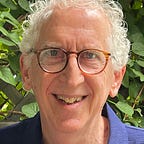For the first time, we were more than pixels
MICS students wrap up their pandemic year with a weeklong experience in the San Francisco Bay Area
By César Vázquez (Medill ‘21)
It’s the first Sunday of August 2021, a few weeks before Medill School master’s students in media innovation and content strategy complete their education.
For the first time since the program started 11 months ago, all of us are together, in one place, in person.
We’re meeting at Northwestern’s San Francisco campus at 44 Montgomery St., in the city’s financial district. The city of San Francisco has had some of the tightest COVID-19 restrictions in the country, making an entire academic term of classes impossible. But for a few days, the classrooms served their true purpose.
Eleven months after the program started, the “Bay Area Immersion Week” was ready to begin.
Rewind to September 2020, when the MSJ program commenced. The students themselves didn’t know for sure what they were signing up for.
The first quarter would have online classes only. Most of us hoped this change would be temporary. We hoped in-person classes would be back soon.
But the realities of remote learning carried on for the entire first quarter … then the second quarter … then the third … then the last.
The benefits of attending a lecture in an actual classroom setting are not just academic.
Time spent physically in a school serves as motivation, or distraction, or even sometimes as a safe place sheltering you from pandemonium happening outside your window.
Any student attending class from a computer screen can tell you how much of a struggle it could be to learn new skills while the world struggled to adapt to a pandemic.
Online school stripped away how students — and instructors — normally showcase their engagement, learning, and growth. Via Zoom, it’s a lot harder for a naturally distracted student to focus, and a lot harder for a professor to understand.
Students and teachers forced themselves to discover how to use the isolation to develop their talents, while maintaining composure, and discreetly reminding themselves to take deep breaths.
We took the breaths and carried on. We were never alone, as much as it felt like it.
We were used to seeing each other through tiny digital windows. Now, our classmates were finally more than pixels.
The point of the Bay Area Immersion Week was to provide a week of in-person classes and a chance to meet professionals who could share insight on what it’s like to work in today’s media and tech industries.
To shake off the rust and the weirdness of being back in a social setting, the week started with a casual dinner in which current students could hear from alumni who completed the program in previous years.
This dinner, and other panels in that week, allowed the students to ask the guests any sort of question. From what it’s like to work at a specific big tech company to managing your own business if you choose to work for yourself.
The week included:
- a kickoff dinner Sunday night, joined virtually by five MSJ alums who have spent their careers in the Bay Area working in media innovation and marketing
- panels on content strategy, the Bay Area startup culture, and product management in media and tech.
- a presentation by Maggie Leung, who recently left her job as vice president of content for NerdWallet to become executive editor for Future.com, a new digital publication from venture capital firm Andreesen Horowitz.
- a virtual visit with CNET, led by editor in chief Connie Guglielmo.
While the presentations and panel discussions were helpful, there was also a chance to experience a traditional classroom. For just this week, the MICS team attended in-person class meetings led by their instructors three instructors: Anthony Jakubiak (Foundations of UX Design), Helen Min (Case Studies in Content Strategy) and David Kopp (Business Models for Media).
The week’s activities were not all entirely serious. The group also visited some of the Bay Area’s iconic spots such as the Ferry Building, the Mission District and, of course, wine country.
During these moments, students didn’t have to be students and teachers didn’t have to be teachers. Sure, they occasionally talked about the classes. They sometimes talked about their job hunts. Most importantly, they just talked. They just joked around. They just finally got to be friends.
Being alongside our peers opened a tiny glimpse into an alternate reality where a global disease wasn’t the root of most news headlines.
After a closing dinner at the end of the week, it was time for everyone to say goodbye, time to go back to their homes across the country, time to get back to online classes for just a little longer.
A year ago, we might not have believed that except for a single week, our entire education would be completed online.
Doing it this way — with this great group of classmates? It was absolutely special.
About the MSJ media innovation specialization
Learn more on the Medill website | Sign up for Medill Media Innovation newsletter
